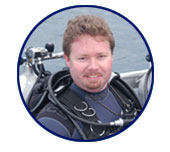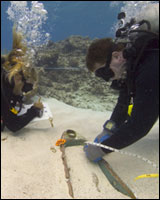 | |||||||||||||
|
|
|
|
|

Deep wreck diving is arguably one of the most dangerous types of diving a person can do. These divers go far beyond the range of recreational diving, which is typically at 130 feet. For the deep divers, and for Tane, their domain is in the 230- to 260-foot regions of the ocean. So what makes a person like Tane dedicate his life to marine archaeology, which will, at times, include deep diving? From swimming to snorkeling to scuba diving, Tane was drawn to the water at an early age while growing up in Hawaii. The 33-year-old, marine archaeologist for the National Marine Sanctuary System knew early on that he would find his way to a maritime career. "Having a Polynesian background also helps. My mother is a Maori from New Zealand and we have close ties to the sea." His childhood wanderlust with the ocean later became a serious career pursuit when he graduated from the University of Hawaii and then in 2005, earned a masters degree from the program in maritime studies at East Carolina University. Before coming to the sanctuary program in 2002, one of his first projects was as a research specialist for the NOAA Fisheries Service in Hawai'i in 1997, assisting in the care of endangered marine mammals and pelagic fish research. That led to other work, including documenting the wreck of the steamer SS Kauai off Mahukona, Hawai'i; a survey of the submerged colonial town of Woodstock, N.C.; and documenting the reck of the Winfield Scott, a side-wheel passenger cargo steamer that sank in 1853 off Anacapa Island in what in now California's Channel Islands National Marine Sanctuary.
But Tane did not become a technical decompression diver merely for personal gratification. He is driven by a desire to bring archaeological discoveries to the public, particularly to raise awareness within local communities that have these resources in their backyards. "These wrecks are links to our past," Tane said. "I like sharing that information with the public. We are bringing history to the people. Think of my job as part historian, part photographer and part detective." Chief among Tane's responsibilities with the sanctuary system is to lead underwater archaeology projects as the principle investigator or to lend technical assistance. Based in Newport News, Va., he has worked on projects in the Florida Keys, Monitor, Channel Islands, Stellwagen Bank and Thunder Bay sanctuaries, among others. One highlight of his NOAA career was leading a team that documented Canada's first naval warship CGS Canada, later re-named the Queen of Nassau, which sank off Key Largo. Playing detective is another thrilling aspect of Tane's work. "After we find an unidentified wreck, the detective work begins to unravel its secrets - what's the ship's name, its origin, and in some cases, its type. Were there survivors? Why did it sink? Was it because of a storm, was the ship under attack, and so on." Next up for Tane-yet another project where he straps on nearly 200 pounds of gear, checks the dive tables one last time, and prepares to enter the water in search of a shipwreck whose secrets have slipped through history's cracks. |

|
|
|||||||
|
|||||||||||||








